After the western region, the south coast of Iceland is the most visited area in the country, partly due to the high concentration of attractions found in the south. Along with stunning waterfalls, there are also glacier lagoons, a plane wreck, black beaches, abandoned farms, hot springs, geothermal areas, and so much more to see.
We have already extensively described most of these wonderful places in our blog. This post serves as an overview page to help those who are preparing for a tour in the south of Iceland.
Let’s get started…
South & Southwest Iceland: What Makes the Region Special
The south, southwest, and southeast of Iceland are mainly characterized by their narrow coastal region. To the north, mountains and volcanoes tower almost the entire length, while to the south, you can see the Atlantic Ocean. From the Ring Road, it is rarely more than 5km and never more than 25km as the crow flies to the sea, and in between, there are often only gray-green lava fields with moss-covered rocks. To the north, at least in summer, the island shows its green side, with dense and beautiful moss growing on the mountain slopes, giving the impression of an ancient realm where a dinosaur might appear at any moment.
There are several attractions to be found in this region. Coming from the west, or Reykjavík, you will pass geothermal areas such as Krysuvik, hot springs like the Reykjadalur river, and then reach well-known waterfalls like Seljalandsfoss and Skogafoss. You will pass directly by the Eyjafjallajökull volcano, continuing east to the small town of Vík with its famous black beach, and then past the picturesque Fjaðrárgljúfur canyon to the glacier lagoons around Jökulsárlón. Further on towards the small town of Höfn, you will pass Skaftafell National Park with its wonderful waterfall, Svartifoss, before leaving the south coast towards the Eastfjords.
You can take a relaxed 2-3 day trip along this route, or spend 2-3 weeks and still not get bored. Day trips to Jökulsárlón Glacier Lagoon from Reykjavík are also very popular.
Regarding the weather, the south coast is rough, but this mainly refers to the wind and winter months. It does not snow as much here as in the north, but when it does, it often comes with strong winds that make driving a challenge, particularly with large vehicles, campers, or RVs. In summer, it is usually sunny, but the wind from the Atlantic can make it extremely chilly. At this time, you should be careful of flying sand; the famous sand and ash insurance may come in handy. But more importantly, keep an eye on the weather forecast.
Along the south coast, there are small to medium-sized towns, and the residents are usually open-minded, as they are accustomed to tourism. Similar to the people in the north, but a bit in contrast to those in the fjords, who tend to be more reserved.
The south is an excellent entry region for travelers to Iceland, as it is easily accessible from Keflavik or Reykjavík, offers many remarkable places, and is well developed for tourism. If you are visiting Iceland for the first time and spending less than a week on the island, it is highly recommended to take a tour along the south coast. Whether by rental car, package tour, bus, or day trips, the south coast of Iceland will not disappoint!
The Weather on Iceland’s South Coast
The weather in the south of Iceland is characterized by the sea: the wind from the Atlantic can blow unimpeded from the south to the north towards the mountains, particularly along the Ring Road, which often runs directly along the coast.
Regardless of the season, you should have some knowledge and estimation of large vehicles, buses, campers, and RVs. Always check the weather forecast and leave the vehicle behind if necessary. The region is characterized by beaches and lava fields, and small stones can often be found lying around which can become projectiles in strong winds: the keyword here is sand/ash/glass insurance. Check out our article on experiences with rental cars in Iceland, as Christine reported such a case.
While it does not snow as much here in comparison to the north, this is rather a matter of numbers: it still snows enough, and the roads are often difficult to clear and drive on due to strong winds. Even if it is only a little slippery: if a strong crosswind pushes your car towards oncoming traffic or the roadside, a road trip can become exhausting or even dangerous.
Apart from driving, which can be avoided entirely through bus tours, there are, of course, other aspects to consider regarding the weather: in the summer, it is great for hiking, and you only need to worry relatively little about rain. Relatively!
Attractions on Iceland’s South Coast
The south coast, with its nearly 450km along the Ring Road, is quite long, especially since it is continuous and not characterized by many twists and turns like the fjords or peninsulas in the west. Accordingly, there are many attractions along the south coast, so you should select the ones you absolutely want to see and factor in the time needed to get there when planning.
We want to provide a comprehensive overview here. If something is missing or you notice any errors, please leave a comment, and we will be happy to look into it.
The Waterfall Seljalandsfoss on the South Coast
Seljalandsfoss is one of the most famous waterfalls in Iceland. With a height of over 65m and its beautiful shape, it is a real feast for the eyes. As a special feature, there is a path that leads directly to the waterfall and behind it: please pack waterproof gear beforehand!
You can see Seljalandsfoss from the Ring Road and drive directly to it by car. There is a large parking lot that costs a few kroner, which is used to maintain the area.
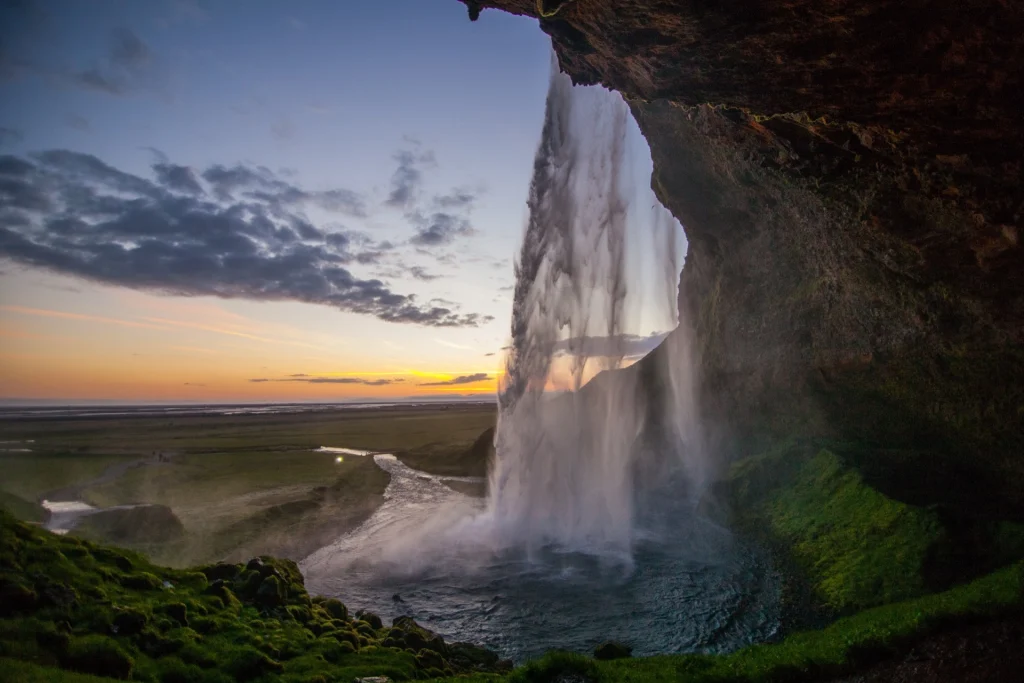
Directly next to Seljalandsfoss is the Gljúfrafoss, the smaller brother, whose name means “the one that hides in the cave.” The name is programmatic, as the somewhat smaller waterfall is actually located in a cave a few hundred meters away and offers a great motif for photos. Again, better show up well prepared!
Skógafoss, another waterfall in the south
The Skógafoss waterfall is only a few kilometers further east from Seljalandsfoss but has little in common with it: where Seljalandsfoss stands out due to its narrow shape, it is the sheer width of over 25m that makes Skógafoss so impressive. The water plunges over 60m into the depths and then flows through the flat landscape directly into the sea.
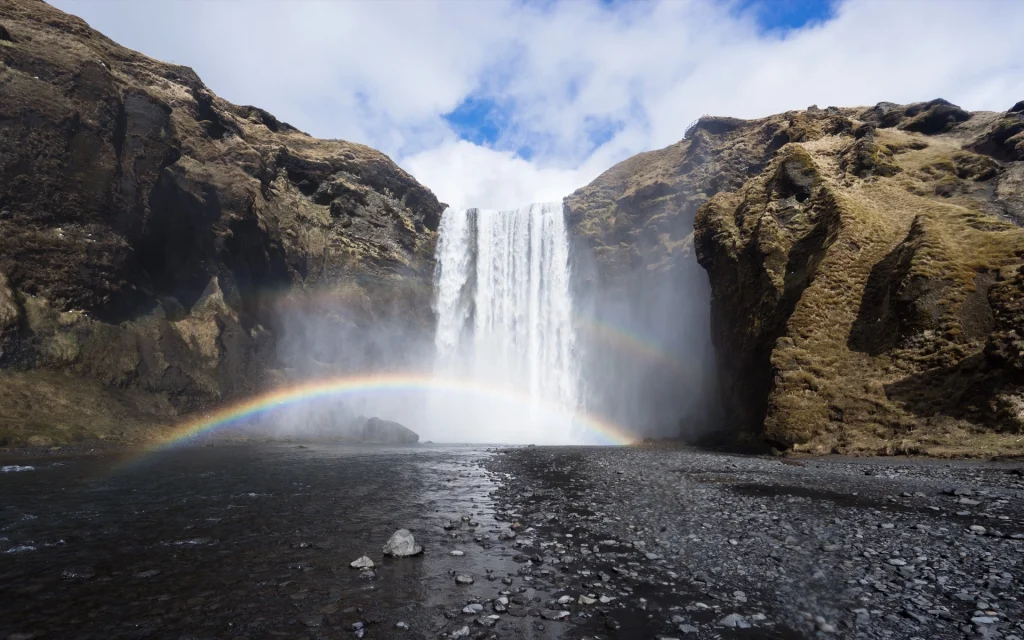
If you’re here, you should do two things: first, climb the viewing platform at the end of the path to the right of Skógafoss, which offers breathtaking panoramas of the landscape down to the sea. Second: take a look at the slope and the black, charred remains of moss that still lie here: this is what happens when fireworks land in the moss. I remember the place being green, so unfortunately, you will never get to know it that way because it takes decades for the moss to regenerate. Sustainable tourism is important to me, and even though the journey along the south coast should be mainly fun, I would like to sensitize you a little to what consequences mass tourism and careless travel can have!
Reykjadalur: Hot Springs on Iceland’s South Coast
The valley of smoke, Reykjadalur, is only about an hour’s drive from Reykjavik. This region above the small town of Hveragerði has a lot to offer: in addition to a large and very active geothermal area, there are great views of the mountains, a large waterfall, and many hot springs that heat up a river to admire.
The hike to the geothermal river in Reykjadalur takes about 2 hours to the small waterfall that feeds the river and about the same time back. So, for safety reasons, you should plan 4-5 hours for this attraction and rather plan it as part of a multi-day tour along the south coast. You pass by fumaroles, mud pots, and hot steam and sulfur smells everywhere from the ground. After a few kilometers, you will then reach a plateau on which there are now fixed wooden paths and small huts. Here you can change and take a short break for a bath.
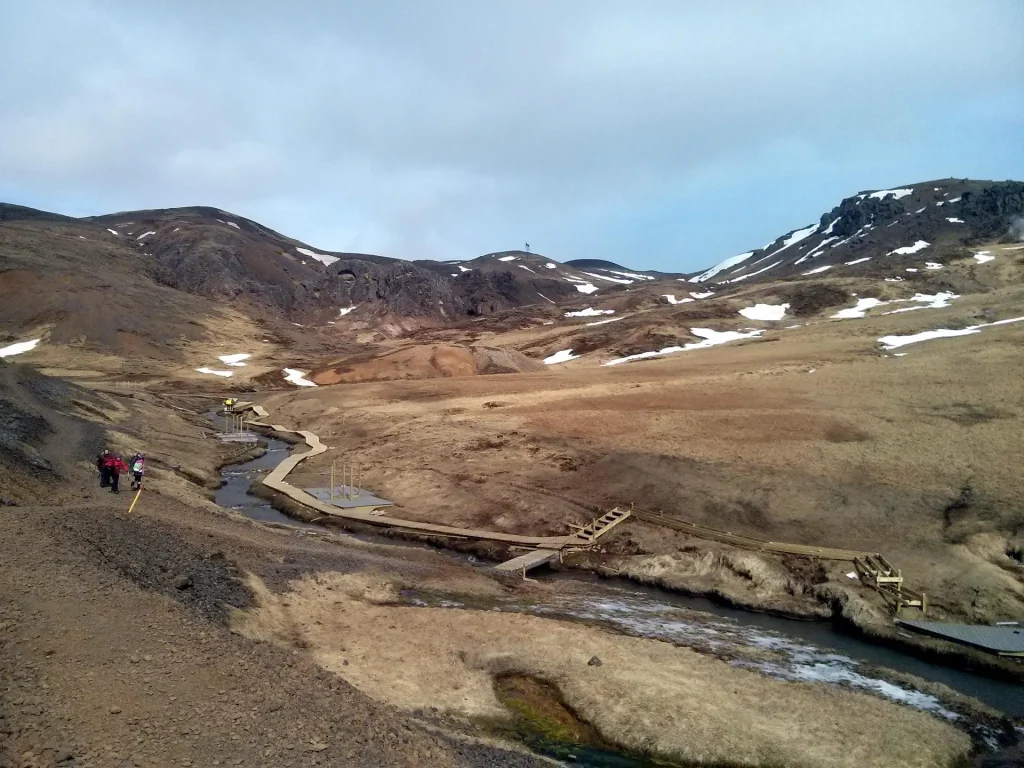
The water of the river is actually ice-cold, but is fed at various points by boiling hot water from the surrounding hot springs. This mixes to a pleasant temperature of just under 40°C and is therefore perfect for a relaxing break even in the depths of winter during a snowfall.
Two things to note: this is a real, natural hot spring, and apart from the wooden planks, nothing has been created by human hands, so temperatures can vary greatly. You can quickly scald your buttocks if a blast of hot water comes out, but it’s not a big deal because you can dip your bum into the ice-cold water a few meters away 😉
The other thing: Please, please leave this place at least as beautiful as you found it, or even better (the way you want to find it yourself). I remember this hot spring when it was completely natural, without any wooden structures, and although these are necessary and good, they are still poorly maintained by visitors. When I’m there, I don’t leave anything behind, and if there’s garbage or something lying around, I pick it up and put it somewhere where it doesn’t bother anyone. I would appreciate it if you did the same!
Jökulsárlón glacier lagoon in southern Iceland
The highlight of any trip along Iceland’s southern coast: the Jökulsárlón glacier lagoon. Many tourists come to Iceland just for this place, which I can understand very well: nowhere else can you get so close to a glacier with such reasonable effort, and all in such a breathtaking setting.
The glacier in question is the Breiðamerkurjökull, at the foot of Vatnajökull, the largest glacier in Iceland and one of the largest in all of Europe. The smaller Breiðamerkurjökull has rapidly retreated in recent years, causing the lake to become larger and growing into a large lagoon. Seals and seagulls can be found here. The latter are happy when a storm washes a load of fish from the sea into the lagoon, providing them with a feast.
In the lake, you can take tours by boat and amphibious vehicles and get a close-up view of the huge icebergs. Such a tour is definitely recommended, and I would always try to book it in advance so that you don’t have a nasty surprise when you get there and find that the boat is already full.
A little note: Please do not step on the icebergs! This is really dangerous, and Icelandic rescue teams are volunteers who would rather do other things than fish people out of the lake.
Next door is Jökulsárlón’s black beach with diamond embellishments: Diamond Beach. Here, many of the icebergs that were carried out to sea or parts of them are stranded, and depending on how the sun shines, the entire beach sparkles like a huge piece of jewelry.
The airplane wreck on the black sand in the south
Especially for those with a passion for cool photos: the airplane wreck of the 1973 United States Navy DC-3 that crashed here.
After the crash, in which nobody was injured, the wreckage was simply left as it was. The electronics, engine, and many other parts were eventually disposed of, but the carcass of the plane still lies in the black sand just off the coast and is rusting away.
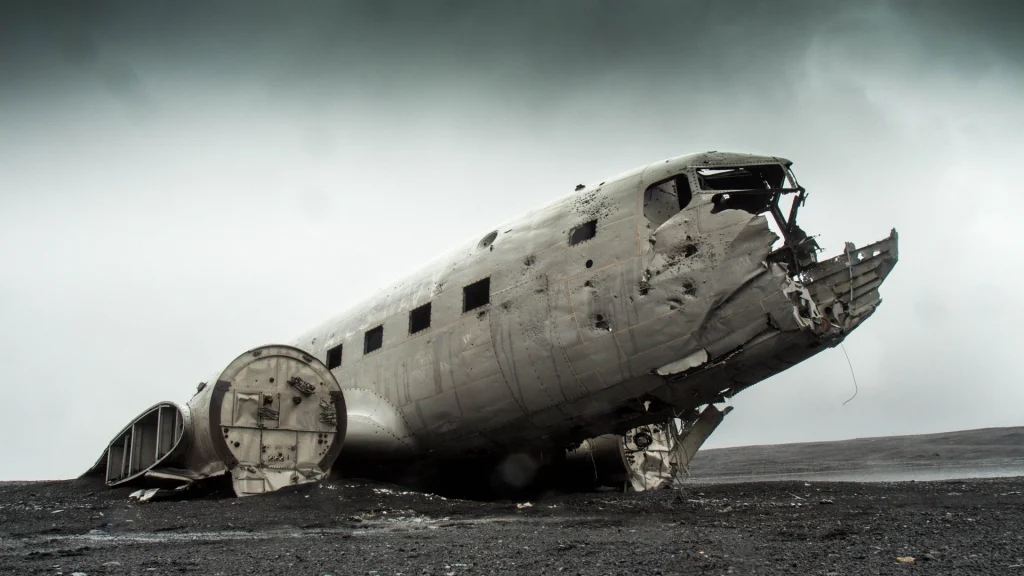
The wreck is on private property, and because tourism became too much, the owner has closed the road to the airplane. So, you have to park a few kilometers before and then walk about an hour.
You will be rewarded, especially in the evenings, mornings, or when there are northern lights over Iceland at night: the surreal motif is simply incredibly well-suited for great memory pictures.
Lava Centre: Learn all about Iceland’s volcanoes in the south
The Lava Centre in Iceland brings visitors closer to the country’s volcanism and geology. However, not like a classic and perhaps boring museum, but in an incredibly modern, tangible, and experiential way.
Through the “Corridor of Volcanoes,” you enter the exhibition, which consists of various rooms and explains the creation of a volcano, the mantle plumes, and the difference between lava and magma, among many other things. In the corridors, you can get a sense of what an earthquake feels like and what it is like to walk through an ash rain during a volcanic eruption.
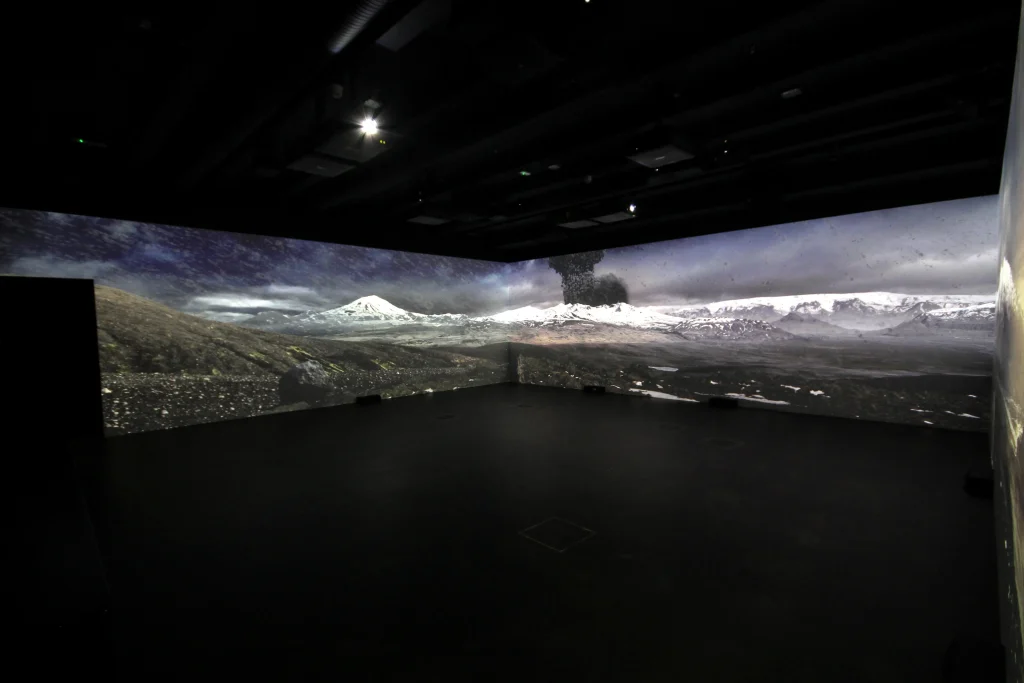
The tour ends in the Hall of Volcanoes, where you get to know all the volcanoes in Iceland by name, or in the adjacent cinema where an exciting film on the topic is shown. A visit is particularly worthwhile early in the morning before the first buses arrive.
Vík, Reynisdrangar, and Reynisfjara: The black beach
The small coastal town of Vík í Mýrdal has a lot to offer: not only is there a beautiful jet-black beach that stretches for kilometers to the east and west, but also majestic rock formations directly in the sea.
The Reynisfjara beach is jet-black due to the ash from previous volcanic eruptions and has been named one of the most beautiful beaches in the world several times. A walk along the Atlantic is particularly worth it at sunset.
Directly on the coast are the Reynisdrangar rock formations. According to a saga, these are three giant trolls who, in an attempt to drag three large ships onto the beach, were surprised by the sun and turned to stone on the spot.
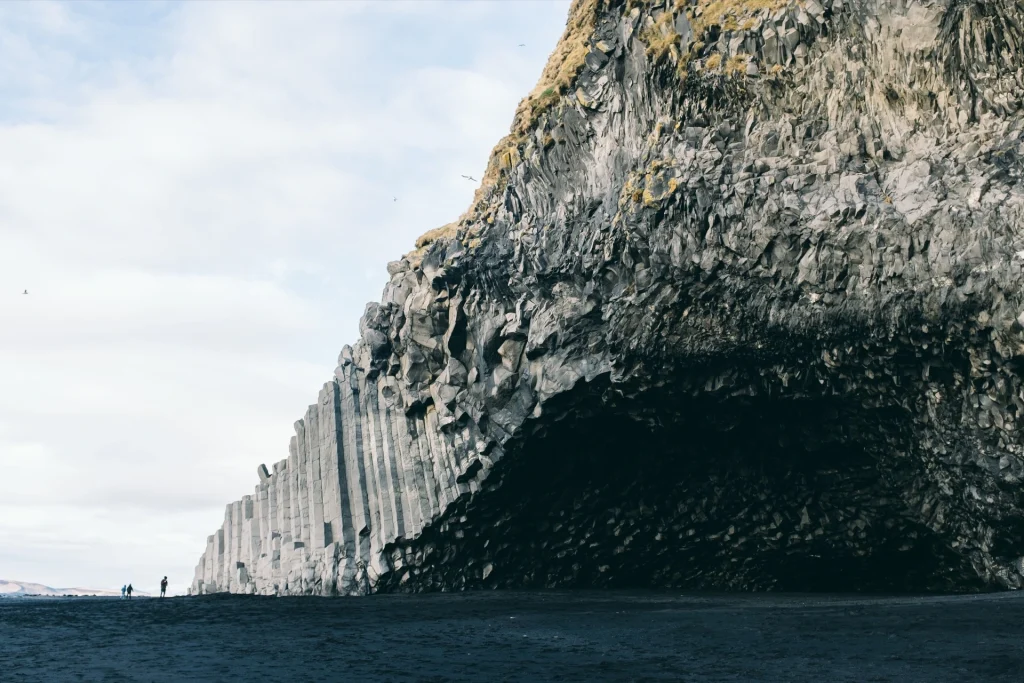
Skaftafell National Park: Well-protected nature in southern Iceland
Skaftafell National Park is located in the south, directly adjacent to the Vatnajökull National Park, to which it has belonged since 2008.
Here you will find untouched nature, as well as the Svartifoss waterfall.
Svartifoss waterfall: The black waterfall on the south coast
Svartifoss is a relatively unknown waterfall on the south coast of Iceland simply because it is too far away on most tours or it is not possible to fit a visit into the schedule.
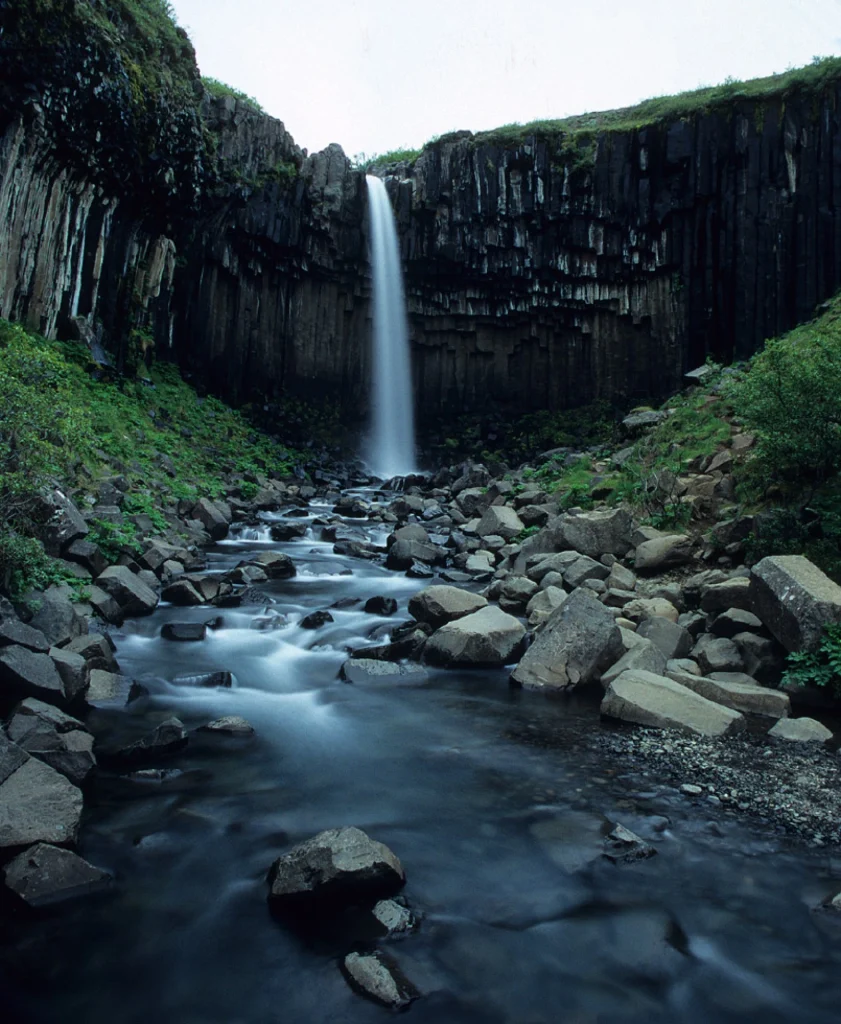
With a height of about 20m, it is not the tallest, but its location in a basalt rock makes it one of the most beautiful of its kind. The characteristic basalt columns that you have already seen in Vík and the surrounding area surround the waterfall and provide a great motif.
South of Iceland: Travel reports from us and others
I have only traveled the south coast of Iceland extensively once, since then I have only been there on day trips or, for example, on the way to the Westman Islands. My personal highlight was clearly the hot river of Reykjadalur and the waterfalls. Surprisingly, the Jökulsárlón glacier lagoon was not such a breathtaking sight for me, because the weather was really terrible on the day I visited it: a completely overcast sky and yet enough June sun to not create a beautiful atmosphere. So, Jökulsárlón is not a particularly memorable place for me, but I am sure to return someday to give the place a second chance.
In the course of this, we would like to include travel reports from others here. Until then, you can already browse the travel reports from Iceland, which often also include the south coast!
What should be considered when renting a car in the south of Iceland?
If you want to travel along the south coast of Iceland on your own, renting a car is absolutely the way to go. Bus tours are often more expensive than renting a car for two people, and in that case, I would always prefer to drive myself rather than being dependent on a bus schedule. Of course, a guided tour offers a little more through the guide, but fortunately, there is the Iceland app for that: Here we have created various tours in Iceland with audio commentaries, so that you can play them during your trip to get more information. The app also offers many other features such as searching for hotels, gas stations, and tours as well as additional content such as the Iceland podcast, which you can also listen to directly in the Iceland App.
Especially in winter, it is advisable to book a suitable rental car in Iceland, as we have mentioned several times before 🙂
The best tours on Iceland’s south coast
Directly after the Golden Circle, tours along Iceland’s south coast are probably among the most popular activities in the country.
Between Reykjavík and the Jökulsárlón glacier lagoon, where tours are usually carried out, there are dozens of stops: the geothermal river in Reykjadalur, the Lava Center, many different waterfalls such as the famous Seljalandsfoss, Skogarfoss, Svartifoss, and several others. Further east, there is the dreamy little town of Vík with its famous jet black beach, the Skaftafell National Park, and later the Jökulsárlón glacier lagoon.
You can see the road ahead of you for kilometers and the corresponding mountains and beaches. Under such conditions, driving yourself is certainly a great option. However, this region can also be difficult, especially in winter: due to the often strong Atlantic winds blowing from the south and sometimes freezing temperatures, it can really be uncomfortable here in autumn and winter. Especially large cars, motorhomes, and campervans have a hard time. At these times, a guided tour with professionals who lead you through Iceland’s landscape in a relaxed and safe manner may be recommended.
Around the area: Making detours from Iceland’s south coast?
From the south coast, especially the Westman Islands (Vestmannaeyjar) are recommended for making a detour, for example, during a round trip around Iceland. From the Ring Road, you only need to drive about half an hour to Landeyjahöfn and take the ferry from there to Heimaey.
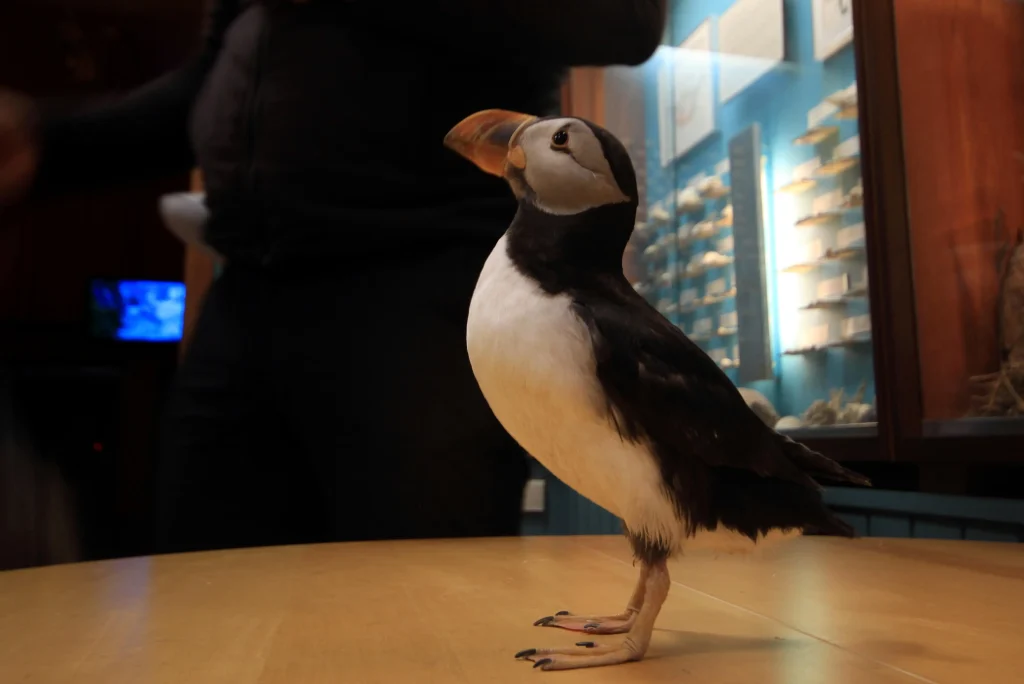
I would recommend spending two full days here, which means booking an overnight stay on the island. The island appears very small, but you can spend several days there exploring in a relaxed manner. We have already written a detailed report about the Westman Islands.
Puffins: The Stars of the Westman Islands / Vestmannaeyjar and Heimaey
Heading north is rather difficult because shortly after Vík, the Skaftafell National Park or the Vatnajökull National Park begins here. Before that, you could drive the famous F26 towards the north and take a tour through the highlands of Iceland. Afterwards, in the east, you are already heading up to the East Fjords. So, it depends on your specific travel planning and route. Apart from the Westman Islands, I would not recommend any other detours.
Conclusion: Iceland’s South Coast
In short, the south coast is one of the most beautiful regions of Iceland and also very popular. Not without reason, because there are really great sights that I would describe as must-see. So, if you are still unsure where to start your first trip to Iceland, the south of Iceland is a good starting point!
As everywhere in Iceland, you should check the weather every day, choose a car suitable for the season, and drive carefully.
If you heed all of this, the south of Iceland is one of the best travel destinations you could wish for!
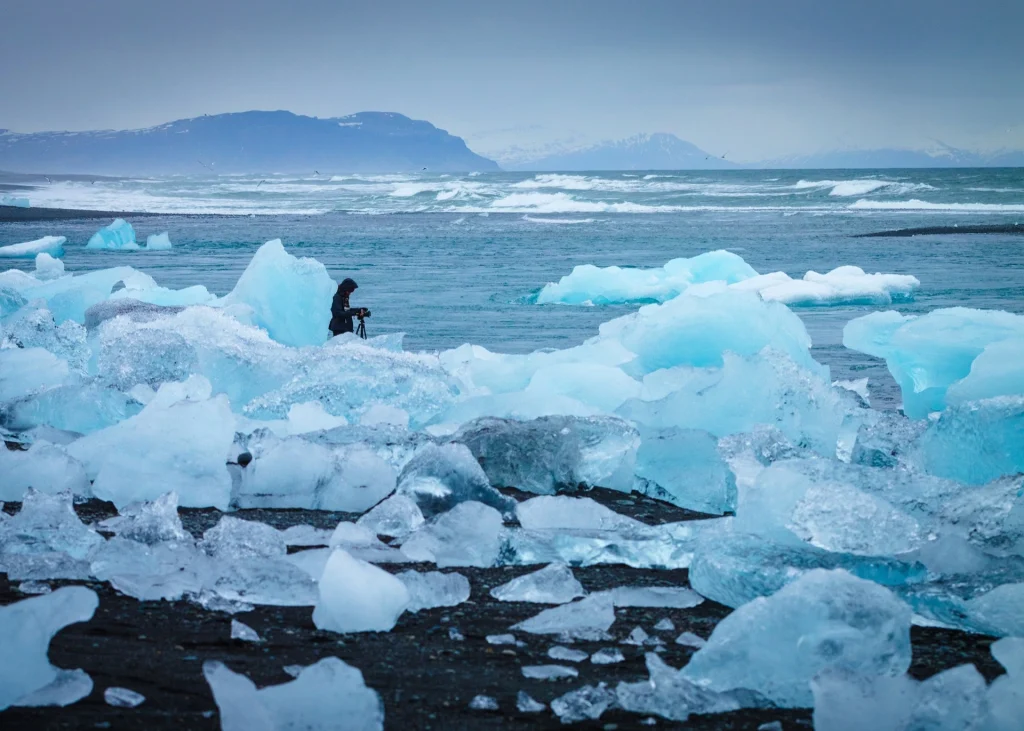
No Comments Yet